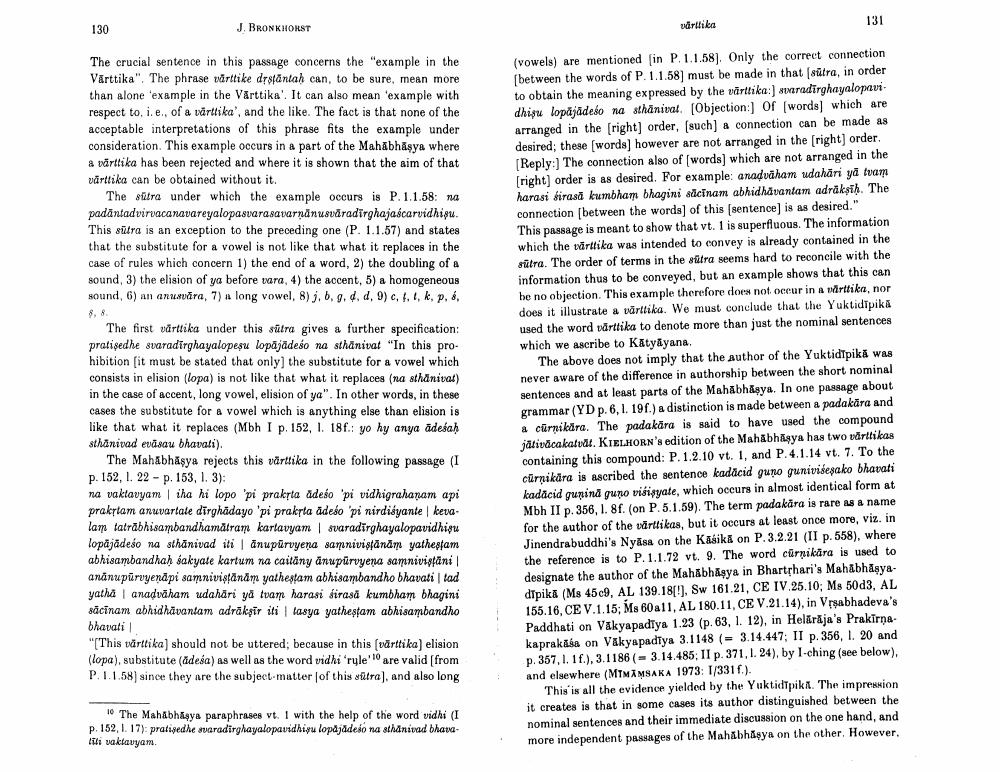Book Title: Archiv Fur Indische Philosophie Author(s): Johannes Bronkhorst Publisher: Johannes Bronkhorst View full book textPage 5
________________ J. BRONKHORST 130 varilika 131 The crucial sentence in this passage concerns the "example in the Värttika". The phrase varttike dysfāntah can, to be sure, mean more than alone 'example in the Varttika'. It can also mean 'example with respect to. i.e., of a vürttika', and the like. The fact is that none of the acceptable interpretations of this phrase fits the example under consideration. This example occurs in a part of the Mahābhāsya where & värttika has been rejected and where it is shown that the aim of that vārttika can be obtained without it. The sutra under which the example occurs is P. 1.1.58: na padantadvirvacanavareyalopasvarasavarnanusváradirghajascarvidhipu. This sūtra is an exception to the preceding one (P. 1.1.57) and states that the substitute for a vowel is not like that what it replaces in the case of rules which concern 1) the end of a word, 2) the doubling of a sound, 3) the elision of ya before vara, 4) the accent, 5) a homogeneous sound, 6) an anusvāra, 7) a long vowel, 8)), b.9. d. d. 9), f.I, k. p. 8, 8.8. The first värttika under this sūtra gives a further specification: pralisedhe svaradirghayalopesu lopājādeso na sthanival "In this prohibition (it must be stated that only) the substitute for a vowel which consists in elision (lopa) is not like that what it replaces (na sthanival) in the case of accent, long vowel, elision of ya". In other words, in these cases the substitute for a vowel which is anything else than elision is like that what it replaces (Mbh I p. 152, 1. 18f: yo hy anya ādeśaḥ Sthanivad evāsau bhavali). The Mahabhāşya rejects this varttika in the following passage (I p. 152, 1.22 - p. 153, 1. 3): na vaktavyam iha hi lopo 'pi prakrta adeso 'pi vidhigrahanam api prakstam anuvartate dirghadayo 'pi praksta adešo 'pi nirdisyante kevalam taträbhisambandhamätram karlavyam | svaradirghayalopavidhiou lopajadešo na sthanivad iti anupūrvyena saminivisanan yathestam abhisambandhah Sakyate kartum na caitäny anuparvyena samnivistani anānupūrvyenapi samniviştanam yathestam abhisambandho bhavati tad yatha anadvāham udahari ya tuam harasi sirasa kumbham bhagini säcinam abhidhavantam adrākşir iti lasya yathestam abhisambandho bhavati "This vårttika) should not be uttered; because in this (värttika) elision (lopa), substitute (adesa) as well as the word vidhi 'rule' are valid (from P.11.58 since they are the subject matter of this stutra), and also long (vowels) are mentioned in P. 1.1.58). Only the correct connection [between the words of P. 1.1.58) must be made in that (sütra, in order to obtain the meaning expressed by the vārtlika:) saradirghayalopavi dhisu lopājādeso na sthanival. [Objection:) of (words) which are arranged in the (right) order, (such) a connection can be made as desired; these words) however are not arranged in the [right] order. [Reply:) The connection also of (words) which are not arranged in the (right) order is as desired. For example: anadváham udahari ya tvam harasi sirasa kumbham bhagini sdcinam abhidhavantam adräksih. The connection between the words of this sentence] is as desired." This passage is meant to show that vt. 1 is superfluous. The information which the vürttika was intended to convey is already contained in the sūtra. The order of terms in the stutra seems hard to reconcile with the information thus to be conveyed, but an example shows that this can be no objection. This example therefore does not occur in a wirttika, nor does it illustrate a vārttika. We must conclude that the Yuktidepika used the word varttika to denote more than just the nominal sentences which we ascribe to Katyāyana. The above does not imply that the author of the YuktidTpika was never aware of the difference in authorship between the short nominal sentences and at least parts of the MahābhAsya. In one passage about grammar (YD p. 6, L. 191.) a distinction is made between a padakāra and a curnikara. The padakära is said to have used the compound jativacakatvat. KIELHORN's edition of the Mahabhaya has two vārtikas containing this compound: P. 1.2.10 vt. 1, and P.4.1.14 vt. 7. To the cürnikära is ascribed the sentence kadăcid guno gunivisesako bhavati kadācid gunina guno višinyate, which occurs in almost identical form at Mbh II p. 356, 1. 8f. (on P.5.1.59). The term padakāra is rare as a name for the author of the varttikas, but it occurs at least once more, viz.in Jinendrabuddhi's Nyāsa on the Käsiki on P. 3.2.21 (II p. 558), where the reference is to P. 1.1.72 vt. 9. The word cūrnikāra is used to designate the author of the Mahabhasya in Bharthari's Mahabhāşyadipika (Ms 45c9, AL 139.18[!), Sw 161.21, CE IV.25.10; Ms 50d3, AL 155.16, CE V.1.15; Ms 60a11, AL 180.11, CE V.21.14), in Vrsabhadeva's Paddhati on Vakyapadiya 1.23 (p. 63, 1. 12), in Heldrāja's Prakirnakaprakasa on Vakyapadiya 3.1148 (-3.14.447; II p. 356, 1. 20 and p. 357, 1.18.), 3.1186(-3.14.485:11 p.371, 1.24), by I-ching (see below). and elsewhere (MTMĀMSAKA 1973: T/331.). This is all the evidence yielded by the Yuktid pik. The impression it creates is that in some cases its author distinguished between the nominal sentences and their immediate discussion on the one hand, and more independent passages of the Mahabhişya on the other. However, 10 The Mahabhasya paraphrases vt. I with the help of the word vidhi (I p. 152, 1. 17) prati edhe siaradirghayalopavidhiyu lopajadelo na sthanivad bhawa lili vaktavyam.Page Navigation
1 ... 3 4 5 6 7 8 9 10 11 12 13
